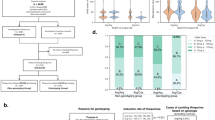Abstract
Background and objective: NV-52 is a novel synthetic flavonoid thromboxane synthase (TXS) inhibitor that may be useful for the maintenance of remission in inflammatory bowel disease (IBD). This study was conducted to determine the single- and multiple-dose pharmacokinetics of NV-52 in nine healthy volunteers (five men, four women; mean [± SD] age 23 ± 2 years).p
Methods: NV-52 400 mg was administered once daily for 10 days (excluding day 2) in an open-label study. Plasma was sampled and urine was collected for 48 hours after the first and last doses. Plasma and urine unconjugated and total (unconjugated plus glucuronide and sulphate conjugated) NV-52 concentrations were measured using liquid chromatography-mass spectrometry.
Results: No adverse events were observed. Unconjugated and total NV-52 appeared and rose rapidly in plasma following the first dose. Time to maximum concentration values were 1.92 ± 1.17 and 2.72 ± 1.52 hours for unconjugated and total NV-52, respectively. Unconjugated and total NV-52 were eliminated with plasma half-lives of 13.12 ± 17.31 and 18.03 ± 19.06 hours, respectively, following the first dose. Pre-dose levels following multiple-dose administration were 135.17 ± 120.03 and 751.9 ± 679.74 ng/mL for unconjugated and total NV-52, respectively. Multiple-dose administration did not significantly alter the pharmacokinetics of NV-52. Renal elimination accounted for about 20–35% of the total (largely conjugated) drug but only 1% of unconjugated NV-52.
Conclusions: Plasma concentrations of unconjugated NV-52 following single-and multiple-dose administration were well above the range found to be associated with suppression of colitis in a murine model of IBD.







Similar content being viewed by others
Notes
The use of trade names is for product identification purposes only and does not imply endorsement
References
Middleton Jr E, Kandaswami C, Theoharides TC. The effects of plant flavonoids on mammalian cells: implications for inflam-mation, heart disease, and cancer. Pharmacol Rev 2000; 52 (4): 673–751
Howes JB, Tran D, Howes LG. Effects of dietary supplementation with isoflavones from red clover on ambulatory blood pressure and endothelial function in postmenopausal type 2 diabetics. Diab Obes Metab 2003; 5: 325–32
Lam AN, Demasi M, James MJ, et al. Effect of red clover isoflavones on COX-2 activity in murine and human monocyte/macrophage cells Nutr Cancer 2004; 49 (1): 89–93
Huang Y, Cao S, Nagamani M, et al. Decreased circulating levels of tumor necrosis factor-alpha in postmenopausal women during consumption of soy-containing isoflavones. J Clin Endocrinol Metab 2005; 90 (7): 3956–62
Verdrengh M, Jonsson IM, Holmdahl R, et al. Genistein as an anti-inflammatory agent. Inflamm Res 2003; 52 (8): 341–6
Duan W, Kuo IC, Selvarajan S, et al. Antiinflammatory effects of genistein, a tyrosine kinase inhibitor, on a guinea pig model of asthma. Am J Resp Crit Care Med 2003; 167 (2): 185–92
Strober W, Fuss I, Mannon P. The fundamental basis of inflammatory bowel disease. J Clin Invest 2007; 117 (3): 514–21
Podolsky DK. The current future understanding of inflammatory bowel disease. Best Pract Res Clin Gastroenterol 2002; 16: 933–43
Feagan BG. Maintenance therapy for inflammatory bowel disease. Am J Gastroenterol 2003; 98 (12 Suppl.): S6–S17
Howes LG, James MJ, Florin T, et al. NV-52: a novel flavonoid anti-inflammatory thromboxane synthase inhibitor for the treatment of inflammatory bowel disease. Curr Opin Invest Drugs 2007; 16: 1255–66
Acknowledgements
The conduct of this study was funded by the drug sponsor, Novogen Pty Ltd. Prof. Laurence G. Howes has previously acted as a paid consultant to Novogen Pty Ltd. The other authors have no conflicts of interest that are directly relevant to the content of this study.
Author information
Authors and Affiliations
Corresponding author
Rights and permissions
About this article
Cite this article
Howes, L.G., Howes, J.B., Huang, J.L. et al. Phase Ib Single- and Multiple-Dose Pharmacokinetic Study of Oral NV-52 in Healthy Volunteers. Drugs R D 9, 159–166 (2008). https://doi.org/10.2165/00126839-200809030-00003
Published:
Issue Date:
DOI: https://doi.org/10.2165/00126839-200809030-00003




